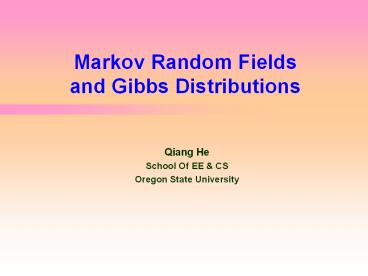Markov Random Fields and Gibbs Distributions - PowerPoint PPT Presentation
Title:
Markov Random Fields and Gibbs Distributions
Description:
A statistical theory for analyzing spatial & contextual ... Isotropy: probability independent of orientations of sites. 17. Bayesian labeling problem ... – PowerPoint PPT presentation
Number of Views:993
Avg rating:3.0/5.0
Title: Markov Random Fields and Gibbs Distributions
1
Markov Random Fields and Gibbs Distributions
- Qiang He
- School Of EE CS
- Oregon State University
2
Contents
1. Introduction
2. Nondirected graphs
3. Markov Random Fields
4. Gibbs Random Fields
5. Markov-Gibbs Equivalence
6. Inference tasks
7. Summary
3
1. Introduction
4
- Markov random fields (MRFs)
- A statistical theory for analyzing spatial
contextual dependencies of physical phenomena. - A Bayesian labeling problem
- A method to establish the probabilistic
distributions of interacting labels - Widely used in image processing and computer
vision
5
- Properties of MRF
- Not ad hoc, can be solved based on sound
mathematical principles (maximum a posterior
probability, MAP) - Incorporating prior contextual information
- Using local properties, which can be implemented
in parallel
6
- An example image restoration using MRF
7
Image restoration process
Goals
- Restore degraded and noisy images
- Infer the true pixels from noisy ones
- Build the neighborhood systems and cliques
- Define the clique potentials for prior
probability - Derive the likelihood energy
- Compute the posterior energy
- Solve the MAP
8
- Definition for symbols
set of sites or nodes
neighbors
a nondirected graph
hidden true pixel
observed noisy pixel
9
2. Nondirected graphs
10
- Neighborhood Systems
- A neighborhood system for is defined as
- where is the set of sites neighboring .
The neighboring - relationship has the following properties
- a site is not neighboring to itself
- the neighboring relationship is mutual
11
Neighborhood Systems
12
- Cliques
A clique is defined as a subset of sites in
, where every pair of sites are neighbors of each
other. The collections of single- site,
double-site, and triple-site cliques are denoted
by , , and , A collection
of cliques is
13
Cliques
14
3. Markov Random Fields
15
- Basics
- Random field A family of rvs
- defined on the set
- Configuration a value assignment on a random
field - Probability
- --discrete case joint probability
- --continuous case joint PDF
16
- Markov random fields
- Positivity
- Markovianity
- Homogeneity probability independent of positions
of sites
- Isotropy probability independent of orientations
of sites
17
- Bayesian labeling problem
18
4. Gibbs Random Fields (GRFs)
19
- Gibbs distribution
- Partition function
Temperature
Energy function
Clique potentials
Special case Gaussian distribution
20
5. Markov-Gibbs Equivalence
21
- Proof MRFGRF
Conditional probability
Extended from clique potentials
Factor into two terms Containing i or not
Remove the term containing i
22
- MRF prior and Gibbs distribution
23
- Posterior MRF energy
Likelihood function
Likelihood energy
Posterior probability
Posterior energy
MAP solution
24
6. Inference tasks
25
- Goals
- Solve the Bayesian labeling problem, that is,
find the maximum a posterior (MAP) configuration
under the observation (simulated annealing
process) - Compute a marginal probability
- (Gibbs sampling)
- Parameter estimation
- Solve MRF prior probability through Gibbs
distribution (since MRFGRF) - Solve likelihood function by estimating the
likelihood energy and the posterior energy
coding method or least square error method - Solve the MAP
26
- Look back at image restoration
- Build the neighborhood systems and cliques
- 4-neighborhood system and two-site cliques
- Define the prior clique potentials
27
- Compute the likelihood energy
- Compute the posterior energy
28
7. Summary
29
- The MRF modeling is to solve the Bayesian
labeling problem, that is, find the maximum a
posterior (MAP) configuration under the
observation - The MRF factors joint distribution into a product
of clique potentials - The MRF modeling provides a systematic approach
in solving image processing and computer vision
problems
30
Thank you very much!































